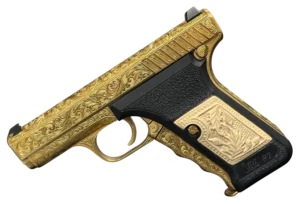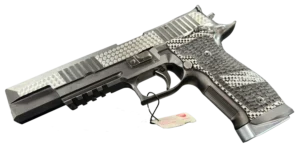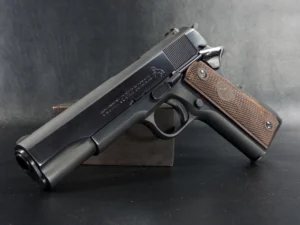Key Takeaways:
- Collectible Firearms Blend History, Art, and Engineering – Firearms are more than weapons—they’re historical artifacts and mechanical marvels. Collectors are drawn to them for their craftsmanship, cultural symbolism, and roles in pivotal moments across history.
- What Defines a ‘Must-Have’ Gun Varies by Collector – Rarity, historical significance, condition, aesthetic appeal, and personal interest all contribute to a firearm’s desirability. Iconic models like the Colt SAA, M1911, Winchester 1873, and AK-47 exemplify this blend of collectibility and legacy.
- Responsible Collecting Requires Knowledge and Care – Building a meaningful collection involves understanding legal requirements, buying from reputable sources like Luxus Capital, and preserving firearms through proper maintenance and storage. Education, ethics, and preservation are essential to long-term enjoyment and historical stewardship.
Let’s get started…
The allure of firearms is undeniable. Their intricate designs, historical significance, and mechanical precision captivate enthusiasts worldwide.
For some, firearms are more than just tools or weapons. They are art pieces, symbols of eras gone by, and tangible links to pivotal moments in history.
This fascination often leads to the creation of impressive collections. Collectors seek firearms that resonate with them, whether due to their rarity, historical value, or sheer beauty.
But what makes a firearm a “must-have” for a collection?
The answer is as varied as the collectors themselves. Some may seek the iconic Colt Single Action Army, the quintessential cowboy revolver that tamed the American West. Others might yearn for the revolutionary design of the AK-47, a firearm that forever changed the landscape of assault rifles.
Then some covet the M1911, a semi-automatic pistol that has stood the test of time, or the Winchester Model 1873, known as “The Gun that Won the West.”
Each firearm has its own story, its place in history, and its unique appeal.
This comprehensive guide will delve into the world of collectible firearms. We will explore the iconic guns that have left indelible marks on history and continue captivating collectors today.
We will also provide insights into what makes a firearm collectible, where to acquire these prized possessions, and how to care for them.
This guide is for seasoned collectors, novice shooters, and history teachers seeking reliable information.
So, let’s embark on this journey together, exploring the must-have guns for collections and the fascinating stories they tell.
The Allure of Collectible Firearms
Collectible firearms have a unique charm that transcends their utility as weapons. They embody history, artistry, and engineering precision, drawing enthusiasts into a world where technology and craftsmanship converge.
For many collectors, firearms’ historical significance is a primary allure. Each gun is a chronicle of the past, offering a tangible connection to pivotal events and figures. From World War II’s battlefields to the American West’s vast plains, collectible firearms serve as artifacts of human endeavor and conflict.
The mechanical intricacy of firearms also captivates. Each component, from the smallest screw to the action mechanism, reflects a level of detail that exemplifies technical mastery. Collectors appreciate the design nuances that differentiate models and demonstrate the evolution of firearm technology over time.
Another aspect of the allure is aesthetic appeal. The craftsmanship of firearms often features fine materials, elaborate engravings, and intricate designs. These artistic elements transform a functional tool into a work of art, appealing to those who admire beauty and craftsmanship.
Beyond aesthetics and history, the community aspect of firearm collecting cannot be overlooked. Collectors often gather to share stories, showcase their acquisitions, and exchange insights. This camaraderie creates a shared experience, enriching the hobby and fostering connections among people with a shared passion.
Defining a “Must-Have” Gun for Your Collection
Choosing a “must-have” gun for a collection involves several considerations. These choices are informed by a blend of personal taste, historical importance, and market value. Each collector defines “must-have” differently, guided by individual interests and goals.
Rarity often drives a firearm’s desirability. Scarce models or those with a limited production run can elevate a gun’s status among collectors. Unique features or markings distinguishing a firearm can further enhance its appeal and significance.
Historical context plays a crucial role too. Guns that have played pivotal roles in significant historical events are sought after. Whether it’s a rifle from a landmark battle or a revolver favored by a famous figure, the story behind the gun can be as compelling as the firearm itself.
Condition is equally essential when defining a must-have gun. A well-preserved firearm holds aesthetic value and may reflect careful stewardship over time. Collectors often seek pieces that have retained their original components and finish without modifications that might detract from authenticity.
Personal affinity also influences a gun’s must-have status. Some collectors gravitate towards specific eras or types of firearms, such as military, sporting, or hunting guns. An emotional connection to a gun can make it a prized possession in a collection.
Key Criteria to Consider
When selecting must-have guns for a collection, consider these factors:
- Rarity: Limited editions and unique variants.
- Historical significance: Association with critical events or figures.
- Condition and originality: Intact components and finishes.
- Aesthetic appeal: Craftsmanship and design.
- Personal interest: Alignment with the collector’s passion or focus.
Ultimately, the definition of a must-have gun varies greatly. It reflects a balance of intrigue, artistry, and historical depth that resonates with the individual collector’s aspirations and preferences.
The Icons of Firearm History
The world of firearms is rich with history and innovation. Icons have emerged, each with its own story and influence. These guns exemplify technical advancement and cultural impact.
Each iconic firearm has forged a legacy. Some were pivotal in conflicts, shaping outcomes and altering history. Others became symbols of change in military tactics and firearm technology.
Collecting these icons is like owning a piece of history. It’s about understanding their role in broader narratives and appreciating their unique characteristics. Such firearms often serve as benchmarks in a collection.
The allure of these guns goes beyond mere appearance. It’s their stories, influence, and craftsmanship that captivate collectors. They speak to a bygone era yet remain relevant to enthusiasts today.
Colt Single Action Army: The Quintessential Cowboy Revolver
The Colt Single Action Army stands as a legend of the American West. Often termed the “Peacemaker,” it embodies frontier spirit and rugged determination. Introduced in 1873, it became synonymous with the cowboy era.
This revolver was renowned for its reliability and simplicity. Cowboys, lawmen, and outlaws all favored it. Its robust design allowed it to withstand the harsh conditions of the wild frontier.
Aesthetically, the Colt Single Action Army is striking. Its classic lines and balance made it a joy to handle. Collectors prize variants with unique finishes or engravings, adding a personal touch to their storied past.
The Colt’s impact on American culture is undeniable. It featured prominently in Western films, securing its place in popular culture. As a collectible, it represents an essential chapter of American history.
For any serious collector, the Colt Single Action Army is a must. Its historical significance, cultural representation, and craftsmanship make it invaluable. It remains a testament to the rugged days of the Old West.
M1911: The Seminal Semi-Automatic Pistol
The M1911 is a masterpiece of design and functionality. Designed by John Browning, it revolutionized semi-automatic pistols. Adopted by the U.S. military in 1911, it served with distinction for over 70 years.
Its .45 ACP round was known for stopping power. Soldiers praised its reliability and ease of use, even under harsh conditions. It was a trusted companion in numerous conflicts.
Craftsmanship set the M1911 apart. Its all-steel construction and precision engineering endeared it to enthusiasts. Variants produced over the decades add to its appeal, offering a rich field for collectors.
The M1911’s cultural footprint is significant. It appeared in countless movies and books, symbolizing American ingenuity. Its legacy is preserved in numerous militaries and civilian usage today.
For collectors, the M1911 is essential. Its historical relevance and engineering excellence make it a cornerstone piece. Owning one is connecting with a storied legacy of innovation and resilience.
Winchester Model 1873: The Rifle That Conquered the West
The Winchester Model 1873 earned the moniker “The Gun that Won the West.” Its lever-action mechanism was revolutionary, offering rapid fire when speed mattered most. Introduced in 1873, it quickly became a favorite among settlers and soldiers alike.
This rifle was notably reliable and versatile. It could withstand the rigors of frontier life while providing the power and accuracy needed for survival. Its widespread use made it a crucial tool in taming America’s wild landscapes.
The Winchester 1873 is iconic design-wise. Its sleek profile and easy handling made it accessible to various users. Collectors often seek models with original finishes or special calibers, highlighting its diverse applications.
The Winchester’s impact transcends its technical prowess. It symbolized the spirit of conquest and exploration. As settlers ventured westward, it was their steadfast companion through trials and triumphs.
For firearm collectors, the Winchester Model 1873 is indispensable. It encapsulates a critical era of expansion and innovation, linking to America’s rugged past. Its presence in a collection signifies a tribute to exploration and endurance.
Luger P08: A German Engineering Marvel
The Luger P08 stands as a testament to German engineering excellence. Introduced in 1898, its distinctive toggle-lock mechanism captured interest worldwide. Used extensively in both World Wars, it symbolizes a pivotal era in firearm history.
The Luger was renowned for its accuracy and precision. Its ergonomic design made it a favorite among soldiers and officers alike, and its 9mm Parabellum cartridge became the industry standard.
Beyond its technical merits, the Luger boasts an aesthetic appeal. Its unique silhouette and mechanical complexity attract both collectors and historians. Various markings and modifications add layers of intrigue to each specimen.
Culturally, the Luger P08 is iconic. It appeared in numerous films, representing a bygone era of warfare and diplomacy. Its role in history and media reinforces its status as a collectible marvel.
Owning a Luger is about appreciating its intricate design and storied past. It embodies a significant period in European history, making it a must-have for those passionate about military firearms. Collectors value its blend of craftsmanship, history, and influence.
AK-47: The Avant-Garde of Assault Rifles
The AK-47 transformed warfare with its simplicity and reliability. Conceived by Mikhail Kalashnikov in 1947, it became the symbol of modern assault rifles. Its design emphasized durability, ease of production, and functionality.
Famed for its robustness, the AK-47 excelled in harsh conditions. Its low-cost manufacture made it accessible and widely produced. This rifle quickly spread across the globe, influencing numerous conflicts and revolutions.
Visually, the AK-47’s utilitarian design commands respect. Its distinct silhouette is recognized worldwide, a testament to its role in modern history. Collectors often seek early models or rare variants for their historical value.
The AK-47’s cultural impact is substantial. It appears in countless films, books, and songs, often representing resilience and conflict. Its presence in art and media emphasizes its lasting influence.
For a collector, the AK-47 is not just a gun; it’s a historical artifact. It signifies a shift in military tactics and remains a powerful symbol of adaptability and survival. Including an AK-47 in a collection embraces a narrative of change and resilience.
Mauser 98: The Benchmark for Bolt-Action Rifles
The Mauser 98 revolutionized bolt-action rifles with its strong and reliable design. Developed in 1898, it became the standard for military rifles worldwide. Its influence has been seen in almost every bolt-action rifle since then.
The Mauser 98 was famed for its smooth action and robust construction. Its ability to handle high-pressure cartridges made it a favorite in military circles. Hunters and marksmen also appreciated its accuracy and reliability.
The Mauser 98’s design excellence sets it apart. Its controlled-feed mechanism and claw extractor were engineering marvels. This rifle’s production quality made it a sought-after piece for collectors.
The Mauser’s legacy is profound. Its use in countless conflicts and its adoption by armies worldwide speak to its effectiveness. This rifle’s influence on firearm design is unmatched, making it a cornerstone in firearm history.
For collectors, the Mauser 98 represents precision and innovation. It stands as a testament to engineering prowess and historical impact. Owning one is owning a piece of the enduring legacy of bolt-action rifles.
Rarity and Value: What Makes a Firearm Collectible?
Understanding what makes a firearm collectible involves evaluating several factors. Rarity often tops the list, captivating collectors worldwide. A gun’s uniqueness can significantly boost its desirability.
Rarity isn’t about numbers alone. It’s tied to historical significance and production history. A firearm with a limited production run often becomes a sought-after piece. This scarcity can make a standard model highly valuable.
Historical context greatly influences a firearm’s value. Guns linked to specific events or people often carry added weight. Their stories and provenance can transform an ordinary weapon into an extraordinary collectible.
Condition plays a critical role in a firearm’s value. Collectors prize firearms in pristine or original condition. Wear, modifications, and non-original parts can significantly diminish a firearm’s worth.
Key Factors in Collectibility
Here are the essential factors contributing to a firearm’s collectible status:
- Rarity: Limited production or discontinued models.
- Historical Significance: Association with historical events or notable figures.
- Condition: Original and well-preserved examples.
- Provenance: Verified ownership history or documentation.
- Cultural Impact: Presence in media or iconic status.
- Aesthetic Appeal: Unique designs or engravings.
Provenance can add immense value to a firearm. Documentation verifying a gun’s past can intrigue collectors. Whether involving a famous owner or pivotal event, this history elevates a firearm’s collectible status.
Finally, cultural impact enhances desirability. Firearms with significant cultural representation often garner attention. Their presence in movies, literature, or art shapes public perception and collector interest.
A collector’s passion for history and craftsmanship often drives demand. Understanding these factors empowers collectors to make informed acquisitions. Each firearm tells a tale, and its unique combination of rarity, history, and appeal crafts its legacy.
Where to Acquire Collectible Firearms
Finding the right place to acquire collectible firearms is crucial. Many platforms exist, each offering distinct advantages. However, the selection process can be daunting for beginners.
Gun shows are popular for their vast array of options. These events offer not only a chance to purchase but also the opportunity to network. Collectors can engage with experts and other enthusiasts.
Auctions have an allure of their own, often featuring rare pieces. Renowned auction houses frequently host events solely dedicated to firearms, which present an opportunity to acquire extraordinary items.
Online platforms offer convenience and a broad reach. Websites dedicated to the firearms trade can connect buyers with sellers worldwide. Yet, caution is needed, as online transactions require thorough research and verification.
Buying from Reputable Dealers like Luxus Capital
Reputable dealers form the backbone of firearm collecting. They provide authenticated and quality firearms, ensuring purchases are worthwhile investments. Luxus Capital is well-regarded in this realm.
Luxus Capital is renowned for its stringent acquisition criteria. This diligence protects buyers from counterfeit items and substandard quality. Collectors trust such dealers for their transparency and expertise.
A dealer’s reputation hinges on its ability to supply genuine collectibles. With years of experience, Luxus Capital offers both credibility and an extensive inventory. Their range caters to both novice and seasoned collectors.
Moreover, purchasing from established dealers often includes support services. Luxus Capital, for instance, assists with legal compliance and documentation. This comprehensive service ensures collectors obtain a product and peace of mind.
The Ethics and Legalities of Gun Collecting
Collecting firearms is a pursuit rich with history and responsibility. Ethical considerations are paramount in this field, and collectors must understand the cultural and historical implications of their items.
Respect for firearms’ provenance is crucial. Each piece carries its story and significance. Collectors should preserve and honor these narratives, recognizing their broader impact on cultural heritage.
Legal considerations cannot be ignored in gun collecting. Regulations vary widely across jurisdictions, and collectors must stay informed about local laws to ensure compliance and legality.
Ownership transfer and documentation are vital legal aspects. Ensuring proper paperwork and background checks protects both buyers and sellers. It also ensures that collections are legally sound and respected.
Responsible ownership extends beyond mere legality. It encompasses safe storage and handling practices. Collectors must prioritize safety to protect themselves, their families, and the public.
Preserving History: Maintenance and Care for Collectible Firearms
Caring for collectible firearms is a blend of science and art. Proper maintenance ensures longevity and preserves historical integrity. Each piece is a testament to craftsmanship and technological evolution.
Basic cleaning methods are essential. Dust and grime can damage metal and wood over time. Regular, gentle cleaning minimizes wear and tear, protecting the firearm’s condition.
Preservation goes beyond cleaning. It’s crucial to control the environment where firearms are stored. Temperature and humidity can significantly impact a firearm’s stability and longevity.
Maintenance should include periodic inspections. Look for signs of rust or corrosion. Early detection prevents minor issues from escalating into significant damage.
Handling is just as important as storage and cleaning. Always handle firearms with clean hands to avoid transferring oils and acids.
Essential care tips include:
- Regular gentle cleaning with soft cloths and appropriate solvents.
- Always store in a controlled environment: stable temperature and low humidity.
- Conduct periodic inspections for rust and corrosion.
- Handle firearms with care, preferably wearing gloves if possible.
- Use proper gun safes to avoid environmental damage.
Collectors must also consider restoration ethics. To maintain historical accuracy, they should opt for preservation over alteration. Professional advice and services can often help.
Overall, a meticulous care routine protects investments and celebrates history. This attention to detail ensures that collectible firearms remain vibrant examples of their time.
Conclusion: Building a Collection That Lasts
Building a firearms collection is a journey of passion and learning. A true collector seeks the beauty in engineering and the stories these pieces tell. Each firearm holds not only historical value but also reflects design and innovation.
Thoughtful curation is key. Focus on quality over quantity. Choose pieces that resonate with your interests and historical significance. This approach ensures a more fulfilling and meaningful collection.
Education is a cornerstone of collecting. Stay informed about firearm history, mechanics, and market trends. Knowledge enhances enjoyment and informs better purchasing decisions. Engaging with communities and fellow enthusiasts offers valuable insights and perspectives.
Commit to preservation and care for each piece. Proper maintenance safeguards against deterioration, preserving the firearm for future enjoyment. This dedication ensures that your collection remains a testament to history and artistry.
A successful collection merges personal passion with historical awareness. It creates a narrative that transcends mere ownership. Each firearm becomes a chapter in a story that connects the past, present, and future generations.
Frequently Asked Questions
A “must-have” firearm typically combines rarity, historical significance, aesthetic appeal, and condition. Iconic status or personal connection can also make a gun a centerpiece in a collector’s collection.
Some widely recognized collectible firearms include the Colt Single Action Army, M1911, Winchester Model 1873, Luger P08, AK-47, and Mauser 98. These firearms are renowned for impacting history, culture, and firearm design.
Collectible firearms can be acquired through gun shows, reputable online platforms, and specialized dealers like Luxus Capital, which is known for vetting and authenticating its offerings. Auctions also offer rare opportunities to acquire unique pieces.
Always comply with local, state, and federal regulations regarding firearm ownership and transfers. Keep thorough documentation, ensure secure storage, and avoid altering historical firearms unless advised by a qualified professional.
Store firearms in a climate-controlled environment, clean them regularly with proper materials, inspect for rust or damage, and handle them with care—preferably with gloves. Avoid over-restoration to preserve historical authenticity.












